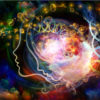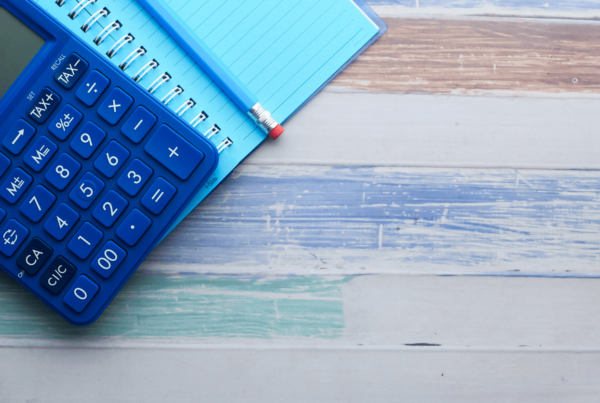This article aims to explain why the 5 senses are not just fundamentally important, but why from childhood to our progressive years, the senses must be trained, protected and stimulated. Continue reading to fully explore your senses
They are the sensory systems that heighten our awareness, protect & excite us, and help us understand our environment. The five senses of Vision, Hearing, Smell, Taste and Touch are sensations that respond to stimuli from our surroundings. The brain utilises this information to gain a better perception of the nature around us.

Image Credit: Five Senses
Why are the 5-Senses important to the human body?
Primarily, the 5 senses act to protect us, whether 1 sense is stimulated or multiple senses come into play. In whichever way you look at their function, the senses act to immediately alert us or guide us to safety. Obvious alerts are things like, sirens that flash in bright colours and make loud sounds. You may smell gas or smoke, which immediately prompts us to check the kitchen burners and prevent a disaster from happening. If we get lost or slightly disoriented, we follow cues from our senses to guide us. Imagine going to the restrooms of various restaurants or offices. We’re quick to get to our destination but getting back to your original starting point seems difficult because we don’t know which labyrinth of doors or stairs to go through to find our seat. By following the sounds of people and by observing the occasional signs, we eventually get back to where we want to be. Whether it’s a light at the end of a forest clearing, or the sound of the road, if we get lost in the woods, our senses will automatically lead the way.

Image Credit: Pexel
Image Credit: Cosmos Magazine

Image credit: Pexels.com
Then, there are those occasions when all senses come alive, such as the sensations created when enjoying food. Excitement is stimulated when we hear food sizzling, we smell the gorgeous aromas and we can see the incredible delight that awaits us. Yet, with the sense of touch, we know when something is too hot to eat, and by taste, we are captivated by the delicious flavour but also aware when something is too spicy or under-cooked. In a nutshell, the senses play a vital role in protection, guidance and excitement.
Exploring each of the 5 Senses:
Hearing
Hearing is our ability to perceive sound, detected through vibrations. It is a mechanical ‘sense’ converting physical vibrations into electrical signals decoded by the brain1. Sound waves move through the ear canal to the eardrum, in the ‘outer ear’. As the sound waves strike the eardrum, vibrations are set into motion which further stimulates the action of 3 small bones in the ‘middle ear’. As the bones vibrate, it causes the movement of fluid in the ‘inner ear’2. This movement of the fluid sparks tiny hair cells to send electrical signals via the ‘hearing’ nerve (auditory nerve) to the brain. The brain receives these electrical impulses and interprets them as ‘sound’.
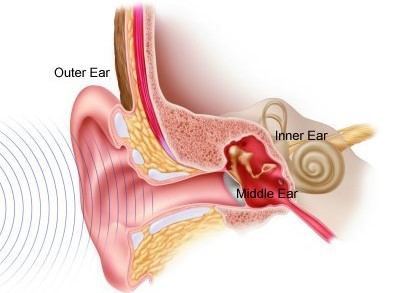
Image credit: LHSC
Hearing and the perception of sound is key for communication. Words, tones and the different types of vibrations are gathered, processed and interpreted by the brain3. Audible notes can vary from harmonious music to warning alerts, so the ‘sense’ of hearing is critical for sustaining a good quality of life. Impaired hearing leads to breakdowns in communication where a person may shut off completely because they cannot hear and participate in conversations. If the hearing is seriously damaged, one can miss warning signals such as a car-horn or a smoke alarm.
Hearing can become impaired due to various reasons. Listening to loud noises for extended periods of time, such as highly amplified music, vehicle engines and factory machines can cause long-term damage to the auditory system4. Hearing loss can also be hereditary, it can be caused by medications (antibiotics, non-steroidal anti-inflammatory drugs, chemotherapy agents), trauma or infection5. The loss of hearing due to ageing is because the delicate auditory system begins to “wear out” as we get older, but the effects are exasperated when coupled with noises that are heard “too loud, too long, too close” 6.
A matter not to be overlooked is that the auditory system also has a vital function to aid ‘balance’. The weakening of the ‘inner ear’ can result in swelling, loss of hearing, dizziness, tinnitus (ringing sounds in the ears without any external stimulus) and imbalance. Too many patients suffer silently with complex ‘hearing issues’, which should be investigated as soon as possible.
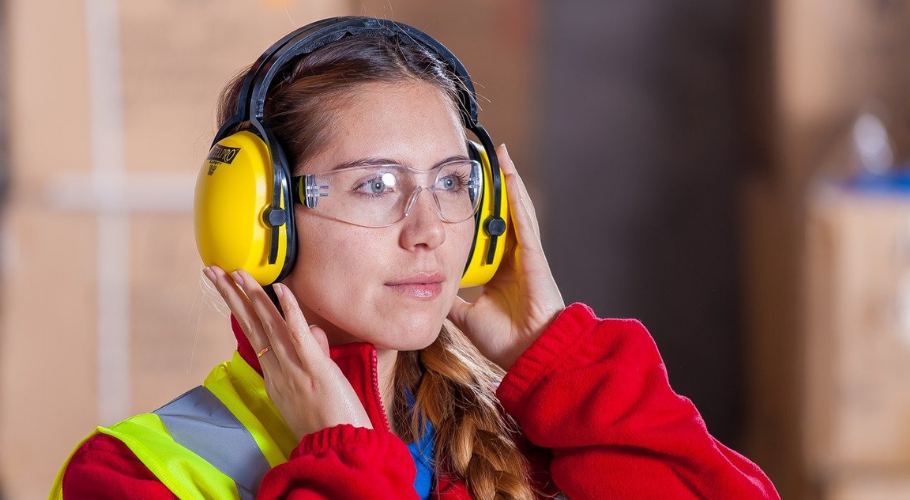
Image credit: Pixabay.com
Gaining further insights from Audiologists (Ear specialist), the recommendation is to prevent hearing loss in the first place. Hence, invest in ear-protection through the application of earplugs or specialised ear-muffs or headphones. An Audiologist will investigate the reason for hearing loss to best determine the solution. The treatment is dependent upon the cause but generally, the remedy can vary from medicine, earwax removal to sophisticated hearing aids and implants7.
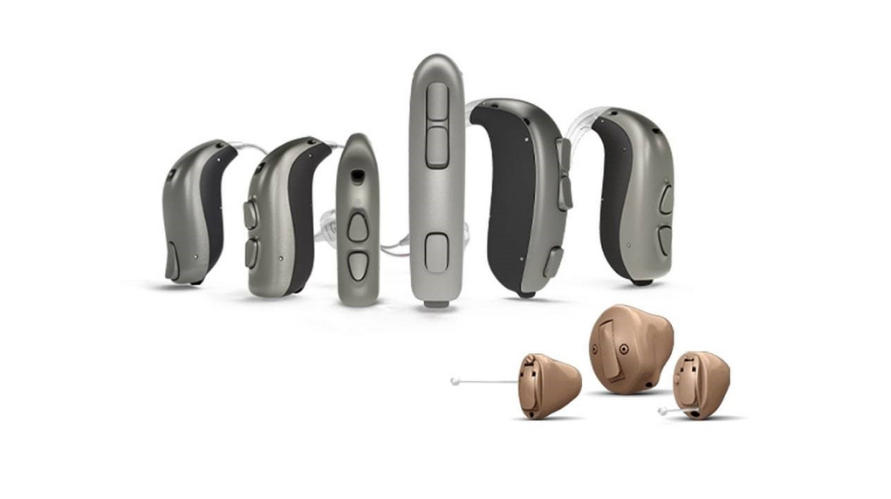
Image credit: Hearing Aids
Hearing aids have evolved leaps and bounds since their early manufacturing designs circa the 1900’s8. As consumer demand seeks comfort, discretion and even style, hearing aids have become smaller and lighter in weight. Needless to say, that these small devices become that much more delicate, so due diligence must be exercised, by the patient, in the maintenance of these instruments.
It is important to have a hearing-check, just as it is advisable to have a routine eye exam or dental check-up. I had the pleasure of having an advanced hearing-test by Mr Sijun Pun Audiologist (MSc) who is highly experienced in both the NHS and private sector. I was pleasantly advised that I had excellent hearing. This would be the ideal norm for everyone, but should there be a reason for concern, it would be detected at the hearing test. If an issue is identified at its early onset, reasonable measures can be put in place to best control and fix any hearing difficulties.
Q&A with Mr Sijun Pun Audiologist (MSc)
Is there a cure for hearing loss?
There is currently no cure for hearing loss. However, to improve the individual’s quality of life, the most popular management option is the hearing aid, which aims to restore the audibility of sounds made inaudible by hearing loss.
There are other management options such as assistive listening devices, Bone anchored hearing aids (BAHA), Contralateral routing of sound (CROS aids) and Cochlear implants. An audiologist can guide you to the most suitable management option depending on the nature and severity of an individual’s hearing loss.
How does hearing loss affect children?
Hearing loss can have a tremendous impact on children. It can cause a significant delay in language development, speech production and perception. For example, a 2-year-old child should roughly be able to use fifty or more recognisable words. However, if the child has a hearing loss this ability may be severely delayed. This can further negatively affect a child’s social life and academics. Thus, early detection with new-born hearing screening and early hearing checks are very important to identify hearing loss in children. This allows early intervention reducing the developmental delay.
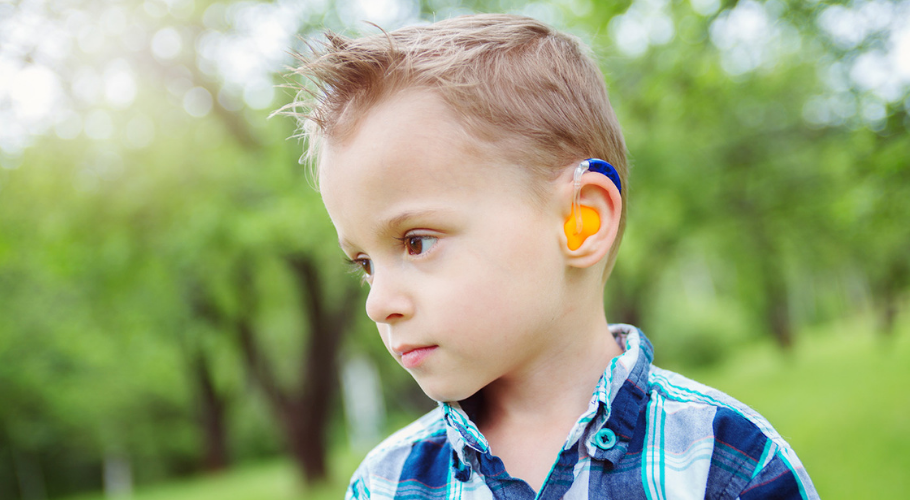
Image credit: Child with hearing aid
Smell (Olfaction)
Olfaction is our chemosensory system most simply known as our ‘sense of smell’. Chemical molecules from various sources of fragrance or odours bind to receptor cells known as olfactory sensory neurons, transmitting a message to the brain to identify the type of smell being perceived9. Various smells pass through the olfactory system and stimulate sensory neurons through 2 pathways. The most obvious pathway is through the nostrils (orthonasal pathway), but the other stimulus is by the retronasal pathway which is via the roof of the throat to the nasal cavity10. Food creates its own scent and when it enters the mouth, trace aroma chemicals pass through this passage to connect at the nasal cavity where the receptor cells connect to the brain helping us to register the source of the smell.
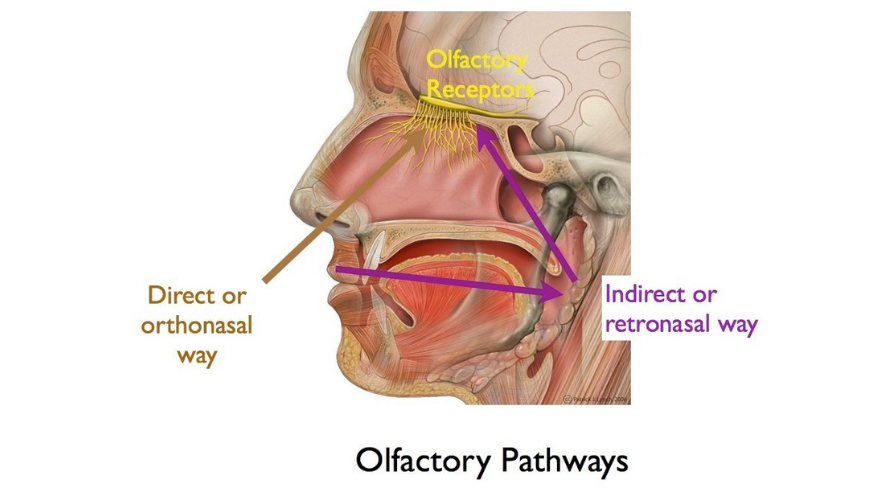
Image credit: Olfactory Pathways
The power of ‘smell’ should not be underestimated. As forementioned, bad smells trigger signs of warning, but scent’s evoke sentiment, memories, relaxation and even stimulus through the power of pheromones. A pheromone is an ectohormone which means it is a chemical substance, secreted externally to be perceived by another individual of the same species11. This discreet odour has the ability to attract someone, as well as identify a parent-child bond12. A small child can quickly recognise their mother, not just by touch but also by their ‘smell’13. Hence, the sense of smell aids our social communication, albeit quietly, without words or visual cues.
A disturbance to the sense of ‘smell’, such as having a cold or flu, by blocking the nasal passages, can affect the ability to appreciate taste and flavour. Both ‘smell’ and ‘taste’ are chemical-sensory systems that work closely together. When a person is ‘bunged up’ they often lose their appetite too.
Olfaction disorders can be triggered by age, respiratory infections, smoking, head injuries, medication (such as antibiotics and antihistamines) and conditions that affect the nervous system (Parkinson’s disease and Alzheimer’s disease)14.
Taste
Taste is a chemical sensation that allows us to discern flavour. Receptor cells or ‘Taste’ buds are located on the tongue as well as the sides, back and roof of the mouth and they bind with food and drink chemicals, to relay this ‘flavour’ information to the brain15. This sensory system of ‘taste’ is known as the ‘Gustatory System’. The most basic classifications of taste can be characterised as salty, sweet, bitter, sour and umami (savoury)16.
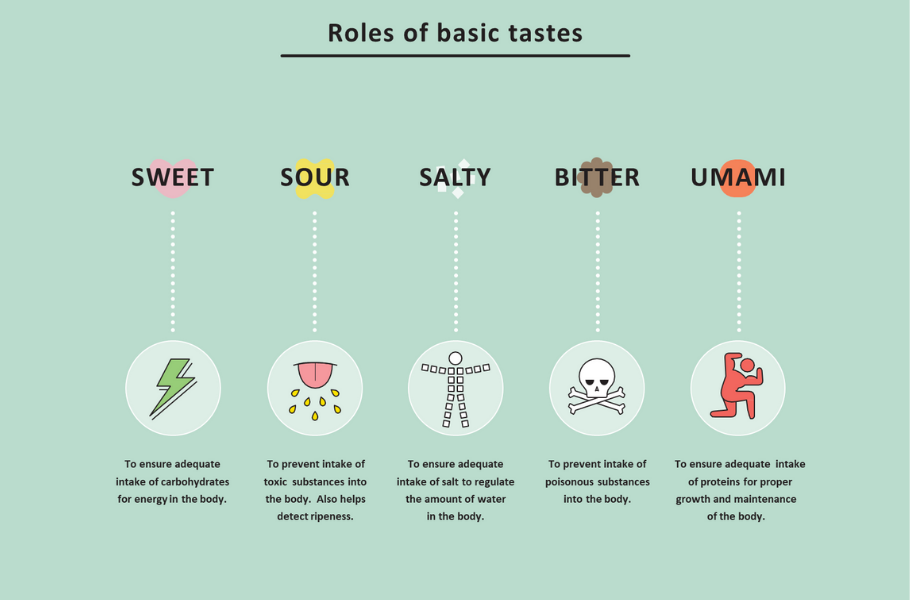
Image credit: ajinomoto.com – What are the 5 basic tastes
Coupled with the sense of ‘smell’ and sensory nerve endings that respond to texture, pain and temperature, the gustatory sensations are heightened to give us the overall experience of the meals and beverages that we ingest. The molecules detected by the taste buds give a measure of toxins, nutrition and ion chemicals that consequently regulate appetite, immunity and gastrointestinal motility17. As soon as a food or drink type is smelt or tasted, it prepares the body for digestion. Receptor cells trigger the release of saliva and digestive juices to prepare for the ingested food to be broken down in the digestive tract.
If the ability to ‘taste’ is diminished, it reduces the faculty to discern between ‘acceptable’ or ‘unacceptable’ food types. The brain does not get the correct signals to determine which food types are nutritional and safe to consume, or toxic to ingest. A simple example of this is when a patient is being treated by strong medication including antibiotics. During the course of the medication, the patient may find that their sense of taste is inhibited. The food feels ‘tasteless’ or bland resulting in them adding more salt to their meal or losing their appetite completely. In the former case, too much salt disrupts the osmotic balance of the body fluids18. In the latter, the patient could lose excessive weight and, in extreme circumstances, potentially lead to malnutrition. Hence, the sense of taste is vital for our wellbeing.

Image credit: Loss of appetite
Most cases of impaired taste are temporary19. It can be caused by infections, such as the common cold or flu, or by the short-term use of medications. However, medical conditions affecting the central nervous system (Parkinson’s disease, multiple sclerosis, Alzheimer’s disease, to name a few), can cause long term loss in the sense of taste. With age, we also lose some of the sensory cells that govern the taste-buds, so consequently, this too would change our sense of taste over time. Other factors that contribute to the loss of taste include smoking, gum disease, respiratory illnesses, radiation therapy, surgeries of the mouth and head injuries20.
Some of the causes for taste-loss, just require lifestyle changes and management (such as quitting smoking and regular oral cavity care). If the loss of taste becomes apparent, it should be investigated further through your GP to facilitate a treatment plan, with the aim to avoid future complications.
Touch
The sense of ‘touch’ is known as the ‘Tactile sense’. Skin is the largest organ of our body21 and so, consequently, it forms the body’s largest sensory structure22. A large network of nerve endings on our skin, contribute to the somatosensory system. The somatosensory system comprises of a complex matrix of receptor cells dispersed inside the body (joint tissues, muscles and tendons) and on the skin (entire body including head and face)23.
Thermal, mechanical and pain receptor cells on the skin, send messages through the nervous system, to the spinal cord and brain, where the type of sensation is deciphered24. Therefore, our tactile sense allows us to ‘feel’ sensations of cold, hot, smooth, rough, pressure, tickle, itch, pain, vibrations and more25.
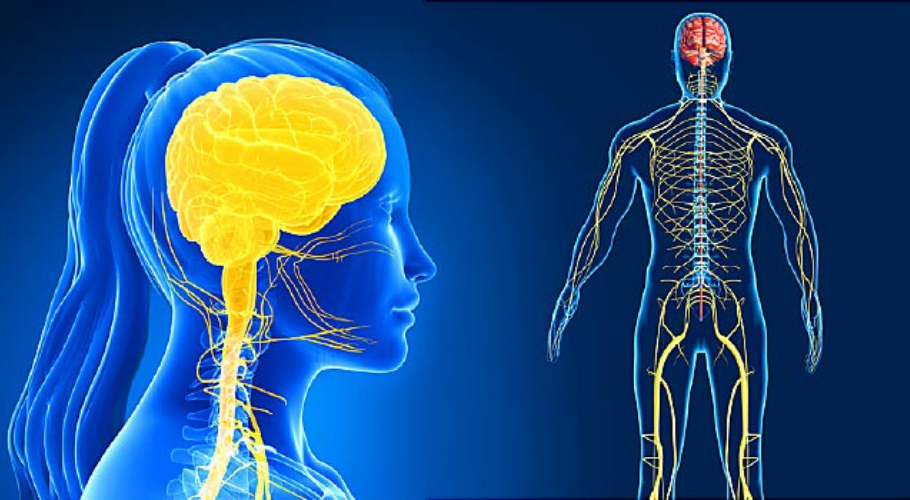
Image credit: WebMB.com – Visual Guide to Your Nervous System
The very first sense that is developed in a child, in foetal form, is the sense of ‘touch’26. The tactile response initially starts from the face, and then over several months starts to function all around the body27. By the time that the child is born, it has already developed one of the most crucial senses for survival.
Touch is a complex ‘sense’ which acts to protect us (awareness of pain), interpret temperature status in our environment, and to give us a general awareness of our surroundings by the objects that we come in to contact with. Adding to this is the interpretation of communication cues stimulated by touch whereby soothing, gentle strokes, prompt feelings of trust and care.
If our ‘tactile’ sense is disturbed, it can trigger symptoms of numbness, tingling, shooting pain, loss of balance (if you cannot feel where you are placing your feet), unusual sensations of hot and cold and muscle weakness28. Causes include trauma, stroke, surgery, diabetes, infections (such as HIV, Lyme Disease, Multiple Sclerosis), reduced blood flow to the nerves and the weakening of sensory cells due to age29. Research has shown that touch deprivation can also lead to feelings of depression. If a person is in distress, a reassuring hug has the ability to comfort them. A caring touch has psychological benefits, giving the feeling of calmness and affection30.
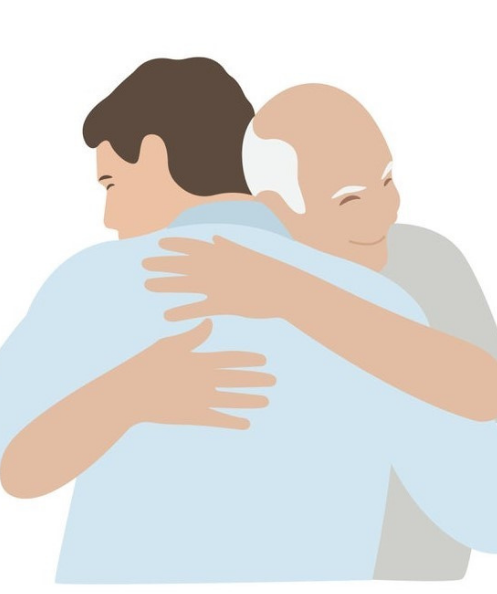
Image credit: The sense of touch in a hug
The best management for the sensory loss of touch would be prevention. Diabetics must control their blood sugar levels to minimise the risk of nerve damage (diabetic neuropathy). Other ways to strengthen the sense of ‘touch’ is to nourish the cells that provide the tactile sense. This can be through multivitamins and minerals specifically including vitamin B12, magnesium and calcium. Steroids may be prescribed to treat nerve damage31.
Vision
The sense of ‘sight’ is the faculty to ‘see’ by means of our visual perception. Light is reflected from objects in our environment to the eye, where it passes through a clear outer layer of the eyeball, called the cornea.
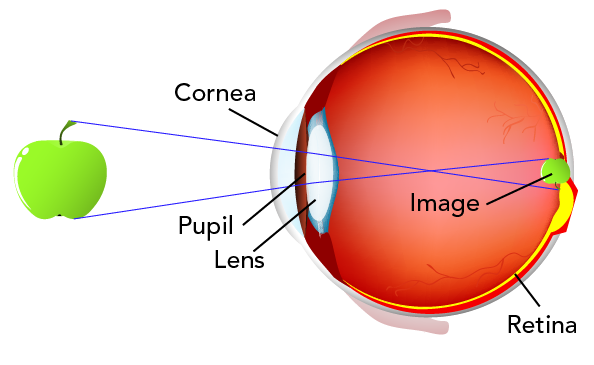
Image credit: Eye with normal vision
The cornea focuses most of the light entering the eye, guiding it through the opening of the ocular media, known as the pupil. The pupil is the aperture of the iris which is the ‘camera-shutter’ system to the eyeball, controlling the amount of light entering the visual system to aid focusing. Light approaches the most natural lens of the ‘visual system’ called the crystalline lens, accounting for approximately one-third of the eye’s optical power, in its relaxed state32.
Passing through the lens, the light rays are focused on the retina where sensory cells, known as ‘rods’ and ‘cones’ (so named after their shapes), relay the light signals, via the optic nerve, to the ‘visual cortex’ of the brain33.
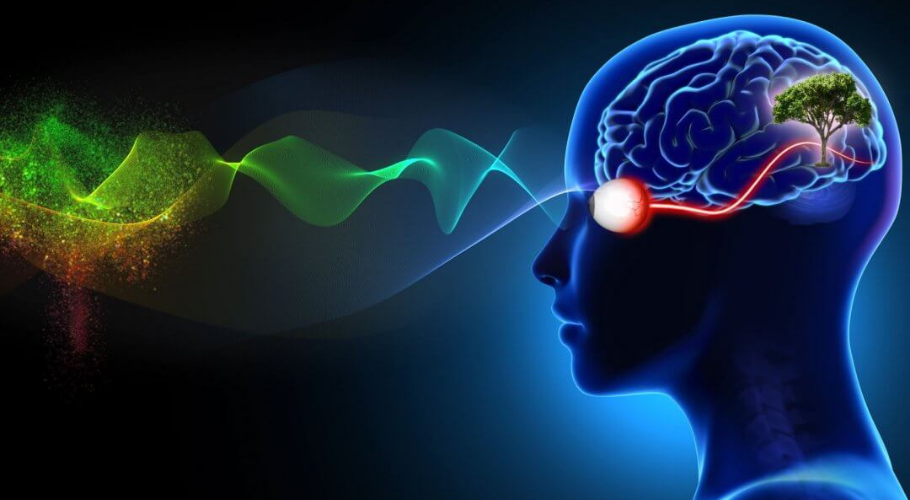
Image credit: BadreMuneer.in – The Colours of Light
The ‘rod’ photoreceptors, function at low-light levels, such as at night time or anywhere in the dark. Rods are better ‘motion’ sensors and aid peripheral vision34. There are more rods in the eye than cones, and the rods are mainly in the peripheral retina. The ‘cone’-like photoreceptors are active at higher levels of light. They react to different wavelengths of the light spectrum, making them responsible for colour vision. Cones are mostly in the centre of the retina, making them important for central vision.
The sense of ‘sight’ is vital for understanding shape, size, colour, depth and motion. From these cues, we have a sense of space, communication, recognition and awareness. The ability to ‘see’ aids the development of learning. When we ‘learn’ from examples, it is usually from a visual stimulus that we develop our skills. In fact, 80% of everything we learn is through the faculty of ‘vision’35.

Image credit: Canva.com
Vision makes us aware of our surroundings; it makes us sensitive to the changes from night to day, and vice versa, and it protects and guides us. With this in mind, every care should be taken to protect the visual system, to sustain a good quality of life.
We know that eye disorders are wide and varied. They can range from prescription anomalies requiring a spectacle correction, to UV damage and cataracts. Symptoms may include blurry vision, double vision, sudden onset of blur, pain, discomfort around the eye, red eye, seeing flashes of light, noting ‘floating’ debris and sudden loss of vision36 to name a few indicators of visual disturbance.
If symptoms should manifest, consult a specialist immediately. Opticians are your ‘go-to’ professionals that can aid with the diagnosis and management of a plethora of eye-related ailments (read The Opticians: The Eye Examination).
Remedies range from spectacle correction and eye-drops to referrals directed towards an Ophthalmologist (eye doctor) for eye conditions that require hospital management. Eye examinations should be a routine part of one’s healthcare regime since some conditions may be asymptomatic such as ‘leaky’ blood vessels in the eye or increased intraocular pressure. If certain eye conditions are not monitored or detected in time, they can lead to further complications including blindness37.
A list of Eye conditions that affect vision38
- Refractive error (when the eye cannot focus an image)
- Keratitis (inflammation of the cornea)
- Retinal detachment (retina pulls away from its normal position)
- Macular degeneration (damage to the central retina)
- Cataracts (clouding of the crystalline lens)
- Glaucoma (optic nerve damage)
- Diabetic retinopathy (damage to blood vessels at the retina)
- Dry eyes (inadequate lubrication of the eye)
- Colour blindness (absence or reduced ability of cone receptor cells at the retina)
- Uveitis (inflammation of the middle layer of the eye)
- Macular oedema (build up of fluid at the centre of the retina)
The most important ‘Sense’
All of the 5 major senses are crucial for survival, but after much research, the general consensus was that ‘VISION’ was the most vital of them all. Exploration on this topic has been deliberated upon for hundreds of years39 but the experts have concluded that ‘sight’ is the most dominant sense in humans. The ‘eye’ is considered to be the most important ‘sensory organ’ of the human body40, with ‘vision’ being the sense that we use the most41.

Image credit: mvEyecare.net – Eyeglasses
Survival & Communication is multisensory
Our senses are always on ‘duty’ even whilst we sleep. Your eyes may be closed, but your hearing and ability to smell will alert you to changes in your surroundings. Anything that is detected in your environment, that is away from the norm, will awaken the senses.
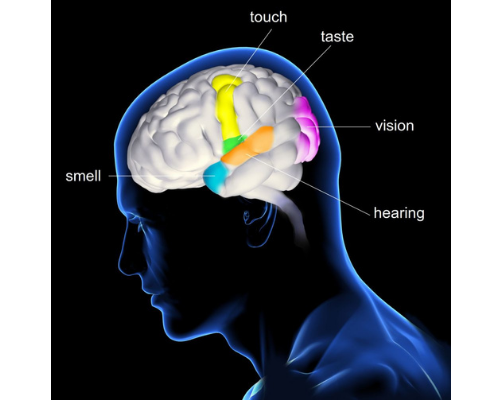
Image credit: thoughtCo.com – five senses
Likewise, communication is also multisensory, using visual, tactile and sound signals to liaise with others42. In conversation with a person, communication is perceived through speech, lip-reading, observing one’s ‘body language’ as well as touch, and being receptive to various tones of dialogue.
Language is not just limited to words, for we know that sign-language can be equally expressive. Reading isn’t absolutely done with our eyes, because we are able to use our sense of touch to ‘feel’ text and interpret braille.
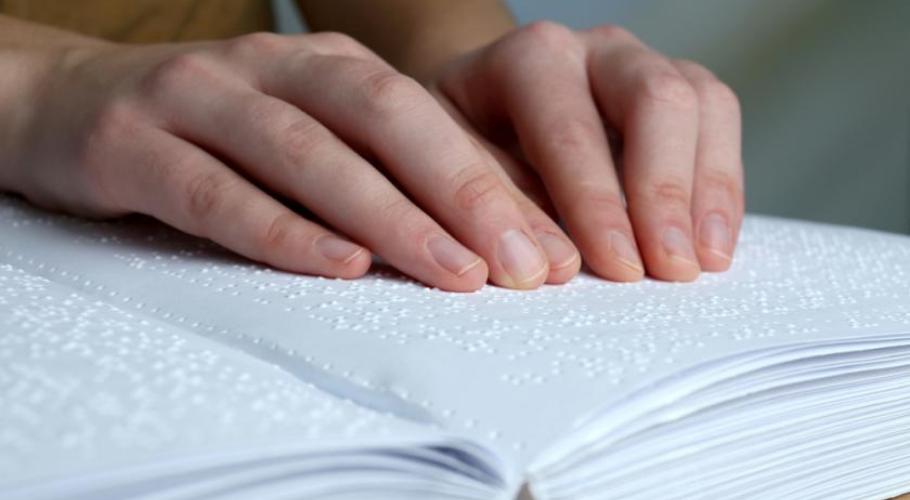
Image credit: Sense of touch and braille
The human body is complex but brilliant. If someone is born with an impaired ‘sense’, the individual has the same innate ability to survive, as someone who is born with all functioning ‘senses’. Not knowing the feeling of the missing sense, it is a natural instinct, to use all the senses that we are born with, to live. If a person is born with an impaired sense, studies have illustrated that the part of the brain dedicated to handling the unused sensory material, re-routes the information to be processed by the other senses43.
When people lose sensory skills due to trauma or via a gradual process, the other sensory systems may become heightened or, through training, developed to adapt. We are able to compensate for the diminishing ability of one sense, by enhancing the other senses. But, a big part of this journey is the individuals drive to do so. The body instinctively wants to live, but it is the ‘willpower’ of the individual that ultimately decides the energy and effort exercised into training the other senses.
A diminishing ‘sense’ can often result in the feeling of losing one’s confidence. For example, hearing loss can result in miscommunication and eventually, the individual may prefer to remain quiet during conversations to avoid embarrassment44. Not to be overlooked is also the increased prevalence of stress, anxiety, loneliness and depression caused by sensory losses45. Older patients with age-related multi-sensory impairment, exhibit a decline in mental processes of perception, memory, judgement, reasoning and emotion. Weakened sensory skills have furthermore been associated with a higher risk for dementia46.
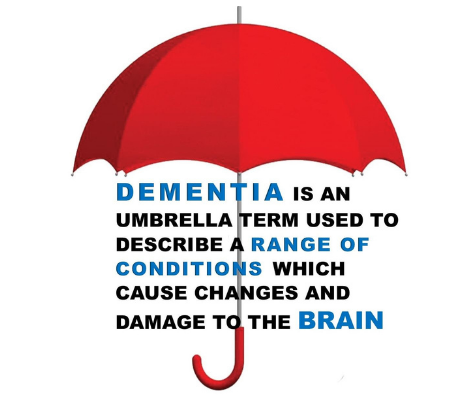
Image credit: KenoshaCounty.org – Dementia Care
Stimulate the ‘Senses’ to protect them:
We have explored the primary senses and their roles in enhancing our lives. Protecting the sensory skills is vital for us to continue collecting information from our environment. From childhood to our working-adult selves, we are learning new skills to improve every aspect of our daily lives. It can be argued that this daily stimulation of all the senses is an effective tool in sustaining the faculties. With this in mind, it makes sense that doctors recommend doses of regular exercise and taking up hobbies as we get older, and approach retirement.
Exercise is important for all facets of well-being, improving not only physical health but also mental acuity and performance. Sustained and regular exercise can help improve cardiac performance, modulate glycaemic control and improve cholesterol and blood pressure amongst other positives; these can have a myriad of health benefits ranging from optimising ocular longevity to maximising the efficacy of the nervous system, important for both vision and tactile responsiveness. Regular exercise can also enhance immunity levels, helping to stave off common colds that can often lead to nasal congestion and ear problem. In essence, 30 minutes of exercise a day keeps the doctor away!
Dr Vikram RS Jhajj, MBBS MRCEM MRCGP
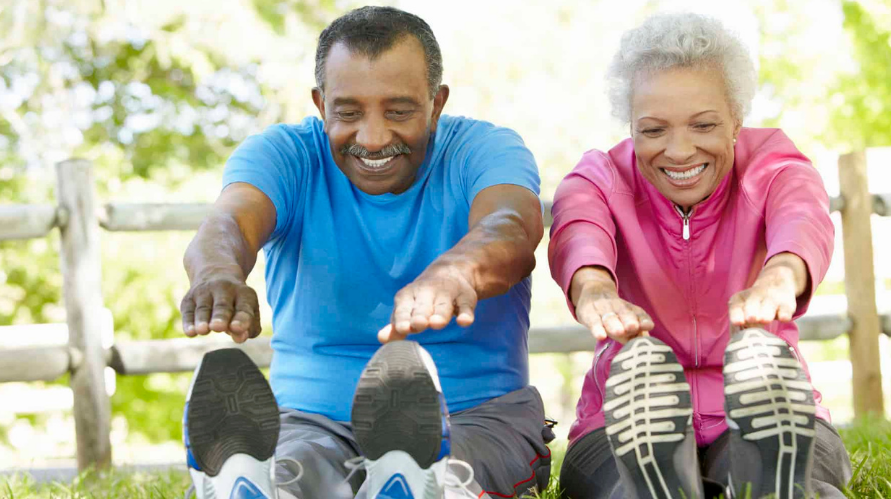
Image credit: Guardian.ng
Exercise and hobbies, continue to stimulate the senses, and consequently the brain. Walking, listening to music and meditation are great mind stimulants. Headspace has summed up the concept of meditation quite nicely by explaining that it ‘trains’ our awareness. Art can be experienced by making something yourself or visiting a museum or gallery to appreciate the art created by others. Whatever the methods, keep the brain ‘alive’. Stimulate the senses continuously to sustain the best quality of life.

Image credit: Canva.com
References:
-
dana.org/article/the-senses-hearing
-
Soundrelief.com/hearing-loss/how-hearing-works
-
Ncbi.nlm.nih.gov/books – information about hearing, communication & understanding
-
Ncbi.nlm.nih.gov/books – information about hearing, communication & understanding
-
Ncbi.nlm.nih.gov/books – information about hearing, communication & understanding
-
Ncbi.nlm.nih.gov/books – information about hearing, communication & understanding
-
www.nhs.uk/conditions/hearing-loss
-
hearingsystemsinc.com/the-history-of-hearing-aids
-
nid.nih.gov/health/smell-disorders
-
thoughtco.com/olfactory-system
-
www.ncbi.nlm.nih.gov – pheromones & their effect on women’s mood and sexuality
-
medicalnewstoday.com – What are pheromones and do humans have them?
-
helloclue.com – scent-attraction-pheromones-cycle
-
nid.nih.gov/health/smell-disorders
-
www.fifthsense.org.uk – what is taste
-
www.healthline.com – health/types of taste
-
en.wikipedia.org – taste receptor
-
sciencedirect.com – An evolutionary perspective on food & human taste
-
healthline.com/health/taste-impaired
-
medicalnewstoday.com – What causes a loss of taste
-
www.nationalgeographic.com/science/human-body
-
link.springer.com – skin sensory mechanisms
-
nba.uth.tmc.edu/neuroscience – chapter 2 – somatosensory systems
-
askabiologist.asu.edu/explore – the sense of touch
-
learning-center.homesciencetools.com – Sense of touch
-
sciencelearn.org.nz/resources – touch
-
utswmed.org/medblog/sensory-development-utero
-
lexology.com/library – sensory loss series – touch
-
healthline.com/health – what is hypoesthesia?
-
medicalnewstoday.com – hugs & kisses: the health impact of affective touch
-
healthline.com/health – what is hypoesthesia?
-
ncbi.nlm.nih.gov – calculation of the crystalline lens power using a modification of the Bennett method
-
ncbi.nlm.nih.gov – neuroanatomy, visual cortex
-
hyperphysics.phy-astr.gsu.edu – rods and cones
-
visioninitiative.org.au/common-eye-conditions – how your eye works
-
visionaware.org/your-eye-condition – signs & symptoms of vision problems
-
healthline.com/health/blindness – what causes blindness?
-
irisvision.com/most-common-eye-problems-signs-symptoms-and-treatment
-
sciencedaily.com/releases – is there a universal hierarchy of human senses?
-
augenklinik-stralsund.de – the eye: the most important sensory organ of the human body
-
proviso.ch – eye and vision
-
ncbi.nlm.nih.gov/books – information about hearing, communication and understanding
-
scientificamerican.com/article – superpowers for the blind and deaf
-
hearingconsultants.com – why are people ashamed of hearing loss?
-
medicalnewstoday.com/articles – what are the true costs of smell loss?
-
medscape.com/viewarticle – impaired senses, especially smell, linked to dementia
Posts by Oodo may include affiliate links. This means that we make a small commission from referrals and purchases at no extra cost to you. Thank you for your kind support.





